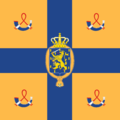أورانج-ناساو
| عائلة اورانج-ناساو House of Orange-Nassau | |
|---|---|
 | |
| البيت الأم | عائلة ناساو |
| البلد | هولندا، إنگلترة، ايرلندة، لوسكمبورگ، اورانج، ناساو |
| تأسست | 1544 |
| المؤسس | وليام الأول من اورانج (وليام الصامت) |
| الرأس الحالي | الملكة بيتركس من هولندا |
| الألقاب | ناساو|كونت ناساو-ديلنبورگ، إمارة اورانج، Stadtholder of various provinces of the Dutch Republic, مملكة إنگلترة، إسكتلندة وايرلندة، أمير كونت ناساو-ديتز، Fürst of Nassau-Orange, Fürst of Nassau-Orange-Fulda، ملك أو ملكة هولندا (اللقب الرئيسي)، دوق ليمبورگ، الدوق الأكبر في لكسمبورگ 1815-1890 |
| الأملاك | هولندا |
| الانحلال | منذ 1962 انقرض الخط الأصلي للأسرة |
عائلة اورانج-ناساو House of Orange-Nassau (بالهولندية: Huis van Oranje-Nassau، النطق الهولندي: [ˈɦœy̆s fɑn oˈrɑɲə ˈnɑsʌu̯])، هي فرع أسرة ناساو الاوروپي، لعبت دوراً رئيسياً في السياسة والحكومة الهولندية — في اوروپا — خاصة في عهد وليام الأول من اورانج (الشهير "بوليام الصامت" أو "والد أرض الآباء") منظم الثورة الهولندية على الحكم الإسپاني، والتي أدت بعد حرب الثمانين عام إلى تأسيس دولة هولندا المستقلة.
أسرة ناساو
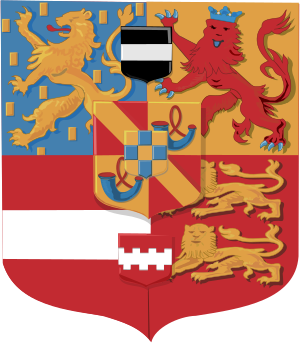
تعود نشأتها إلى أوائل القرن الثاني عشر. حين شيّد النبلاء الألمان قصراً في ناساو على ضفاف نهر اللان وصار مسقط رأس هذه الأسرة، وكان روبرت الأول المتوفى عام 1154 ومن بعده والرام المتوفى عام 1198 قد حملا لقب كونت ناساو.[1]
انقسمت هذه الأسرة عام 1255 بعد وفاة الكونت هنري الثاني إلى فرعين الفرع الأول انحدر منه حكام دوقية لكسمبورگ الحاليون، والثاني المعروف باسم أورانج ناسّاو وانحدر منه ملوك هولندا الحاليون. وكان لهذا الفرع أثر كبير في تاريخ هولندة والمقاطعات المجاورة لها. بل في تاريخ عدد من الدول الأوربية القريبة من هولندة. ويبدأ تاريخ هذه الأسرة في العصور الحديثة منذ عصر گليوم الأول (1559-1584) ويُعرف بالسَّكوت أو الصَّموت وكان يحكم هولندا وزيلندا وأوترخت، وله أثر مهم في محاربة الإسبان لإخراجهم من بلاده. خلفه ابنه الثاني موريس ـ ناساو (1567-1625) فتابع سيرة أبيه في إسبانيا. وحكم من بعده أخوه فيليب غليوم ثم الأخ الثالث فريدريك هنري (1584-1647) وكلهم عمل للهدف نفسه وهو الاستقلال عن إسبانيا. وقد تحالف هذا الأخير مع فرنسة عام 1635 واسترد مدينة بريدا شمال شرقي برشلونة في إسبانيا. وفي عهده أيضاً تمكن الأميرال مارتن ترومپ من إلحاق هزيمة ساحقة بالأسطول الإسباني عام 1639.
التمرد الهولندي
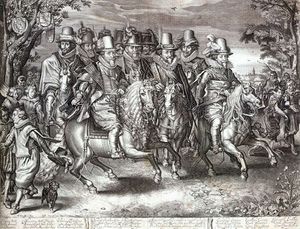
تقرب ملك إنگلترة شارل الأول من فريدريك هنري فتزوج ابنته الأميرة ماري عام 1641 التي أنجبت منه ابناً إنگليزياً ـ هولندياً مهَّد لأسرة أورانج الطريق إلى عرش إنگلترة.
واستأنف فردريك هنري حربه مع إسبانيا بين عامي (1644-1647) وانتصر عليها وأجبر إسبانيا على الاعتراف باستقلال المقاطعات المتحدة (أكبرها هولندا)، ولكنه توفي قبل أن توقع معاهدة مونستر عام 1648.
ثم تولى الحكم في هولندا گليوم الثاني مدة ثلاث سنوات (1647-1650)، وبعد وفاته بأسبوع أنجبت أرملته ابناً هو گليوم الثالث (1650-1702) الذي حكم هولندا بين 1672 و1702. وفي عام 1689 تولى عرش إنگلترة وإيرلندة أيضاً. وبوفاة گليوم الثالث انتقل حكم هولندة إلى سلالة گليوم السَّكوت في شخص جان گليوم فريزو وجاء بعده ابنه الملقب بگليوم الرابع أورانج (1711-1751)، وبعد وفاته قامت أرملته بالوصاية على ابنه گليوم الخامس الذي تسلّم السلطة عام 1766.
اتساع نفوذ الأسرة
المنفي والتجديد
في عهد غليوم الخامس وقفت هولندة مع الثورة الأمريكية في مواجهة الاستعمار الإنكليزي عام 1776 من دون أن تعلن ذلك رسمياً مما أدى إلى ظهور تيار مؤيد للثورة الفرنسية على الملكية ولكن فلهلمينا Wilhelmine زوجة غليوم الخامس تغلبت على هذا التيار وعادت لغليوم الخامس سلطاته الكاملة. بيد أن قوات الثورة الفرنسية اجتاحت مملكة غليوم الخامس عام 1795 وطردته مع أسرته فلجأ إلى إنكلترة. وقامت في هولندة والمقاطعات المجاورة جمهورية باتافية التي ألغاها نابليون بونابرت وضم هولندة إلى امبراطوريته.
نهاية الجمهورية
ولما تحررت هولندة من سيطرة نابليون بعد هزيمته في موقعة الأمم (لايبزغ 16-19/تشرين الأول 1813 ضد الحلفاء النمسة وبروسية وروسية والسويد) تولى الحكم غليوم السادس وكان أبوه قد توفي في منفاه عام 1806.
الملكية (منذ 1815)
اعترف مؤتمر فيينا عام 1815 بغليوم السادس ملكاً على هولندة تحت اسم غليوم الأول وكانت هولندة آنذاك تضم بلجيكة. ولكنها خسرت سيطرتها على بلجيكة عام 1830 بعد ثورة البلجيك عليها. وتنازل غليوم الأول عن العرش لابنه غليوم الثاني (1792-1849) وتحت تأثير ثورات 1848 في كثير من دول أوربة على الحكم المطلق نادى الزعيم الليبرالي جوهان رودولف ثوربيك Thorbecke بنظام جديد يجعل الملكية الهولندية دستورية.
وفي عام 1849 توفي غليوم الثاني وخلفه ابنه غليوم الثالث الذي قبل بالنظام الدستوري مكرهاً. وأصبح ثوربيك رئيساً للوزراء يمارس صلاحيات واسعة. وجدت الأسرة المالكة الهولندية أنَ تعايشها مع النظام الدستوري أمر لابد منه فقبلت به رسمياً منذ عام 1868. وبعد وفاة غليوم الثالث 1890 خلفته ابنته الملكة فلهلمينا، وكانت في العاشرة من عمرها فتولت أمها إيمّا Emma الوصاية عليها حتى عام 1898.
ثم تزوجت فلهلمينا هنري دوق ميكلنبورغ وأنجبا ابنتهما الوحيدة جوليانا عام 1909. وقفت هولندة على الحياد في الحرب العالمية الأولى، ورفضت الملكة فلهلمينا طلب الحلفاء المنتصرين تسليم الامبراطور الألماني غليوم الذي لجأ إلى هولندة بعد هزيمة بلاده.
وفي عام 1940 في أثناء الحرب العالمية الثانية ـ غادرت فلهلمينا مع حكومتها هولندة بسبب اجتياح ألمانية النازية لبلادها. ولكنها عادت عام 1945 عودة المنتصرين وحكمت حتى 1948. نزلت عن عرشها لابنتها جوليانا وانصرفت لكتابة مذكراتها وتوفيت عام 1962، واستمرت جوليانا على العرش الهولندي حتى عام 1980 حين نزلت عن العرش لكبرى بناتها بياتريكس Beatrix من زوجها الأمير برنارد Bernard de Lippe-Biesterfeld، وهي ملكة هولندة الحالية، وقد ولدت عام 1938، وتزوجت عام 1966 الأمير الألماني كلاوس فون آمزبرغ Claus Von Amsberg وهي حلقة من سلسلة أسرة أورانج ـ ناسّاو.
وقد أطلق اسم أورانج ـ ناسّاو أيضاً على مجموعة القوانين المدنية والعسكرية التي أعلنت في هولندة عام 1892 وذلك في عهد الأميرة إيمّا الوصية على ابنتها الملكة الصغيرة فلهلمينا ملكة هولندة في ذلك الوقت.
العائلة الملكية
شجرة العائلة
}| John V Count of Nassau-Dietz, 1455-1516, Stadholder of Gelderland | John IV Prince of Orange, 1475-1502 | ||||||||||||||||||||||||||||||||||||||||||||||||||||||||||||||||||||||
| William the Rich Count of Nassau-Dillenburg 1487- 1559 | Henry III Count of Nassau-Breda 1483-1538 | Claudia of Châlon 1498–1521 | Philibert of Châlon, Prince of Orange, 1502-1530 | ||||||||||||||||||||||||||||||||||||||||||||||||||||||||||||||||||||
| William I "the Silent" 1533-1584, Prince of Orange 1544, Stadholder of Holland, Zealand & Utrecht, assassinated by Spanish agent | Louis 1538–1574 died in battle against Spain | Adolf 1540–1568, died in battle against Spain | Henry 1550-1574 died in battle against Spain | John VI "the Elder" 1535–1606, Stadholder of Gelderland | René of Châlon 1519–1544, Prince of Orange,1521 | ||||||||||||||||||||||||||||||||||||||||||||||||||||||||||||||||||
| Philip William 1554–1618, Prince of Orange, 1584 | Maurice 1567–1625, Prince of Orange,1618, Stadholder of Holland, Zealand, Utrecht, etc. | Frederick Henry 1584–1647, Prince of Orange, 1625, Stadtholder of Holland, Zeeland, & etc. | Louise Juliana 1576-1644 married Frederick IV Elector Palatinefrom whom the British royal family descends | Elisabeth 1577-1642 married Henri de La Tour d'Auvergne, Duke of Bouillon | William Louis "Us Heit", Count of Nassau-Dillenburg 1560–1620, Stadtholder of Friesland, Groningen, and Drenthe | Ernst Casimir, Count of Nassau-Dietz 1573–1632, Stadtholder of Friesland, Groningen, and Drenthe | John VII "the Middle", Count of Nassau-Siegen, 1561–1623 | ||||||||||||||||||||||||||||||||||||||||||||||||||||||||||||||||
| Frederick V, Elector Palatine, 1610 & King of Bohemia 1619-21 | Henri de la Tour d'Auvergne, Vicomte de Turenne & Marshal-General of France 1611-1675 | ||||||||||||||||||||||||||||||||||||||||||||||||||||||||||||||||||||||
| Charles I, King of England 1625-1649 | |||||||||||||||||||||||||||||||||||||||||||||||||||||||||||||||||||||||
| Charles II | |||||||||||||||||||||||||||||||||||||||||||||||||||||||||||||||||||||||
| William II 1626-1650,Prince of Orange & Stadholder of Holland, Zealand, etc, 1647 | Mary,Princess Royal | James II | Albertine Agnes | William Frederick,1613-1664 Count later Prince of Nassau-Dietz,Stadtholder of Friesland, Groningen and Drenthe | Henry Casimir I Count of Nassau-Dietz,1612–1640,Stadtholder of Friesland, Groningen and Drenthe | John Maurice "the Brazilian", Prince of Nassau-Siegen,1604–1679,gov. of Dutch Brazil, Field Marshal of the Dutch Army | |||||||||||||||||||||||||||||||||||||||||||||||||||||||||||||||||
| William III 1650-1702,Prince of Orange 1650, Stadholder of Holland, Zealand, etc, 1672, King of England, 1689 | Mary II of England | Henry Casimir II, Prince of Nassau-Dietz,1657-1696,Stadtholder of Friesland, Groningen and Drenthe | |||||||||||||||||||||||||||||||||||||||||||||||||||||||||||||||||||||
| John William Friso 1687-1711, Prince of Orange, 1702, Stadholder of Friesland 1696 | |||||||||||||||||||||||||||||||||||||||||||||||||||||||||||||||||||||||
| Anne, Princess Royal of England | William IV 1711–1751, Prince of Orange, Stadholder of Holland, Zealand, etc. 1747 | ||||||||||||||||||||||||||||||||||||||||||||||||||||||||||||||||||||||
| Wilhelmina of Prussia | William V 1748–1806, Prince of Orange,1751 Stadholder of Holland, Zealand, etc. 1751-1795 | Carolina 1743–1787 | Charles Christian, Prince of Nassau-Weilburg, 1735-1788 | ||||||||||||||||||||||||||||||||||||||||||||||||||||||||||||||||||||
| William VI, Fürst of Nassau-Orange-Fulda 1803–1806, Fürst of Nassau-Orange, Prince of Orange 1806 later William I, King of the Netherlands 1815 | Frederick William, Prince of Nassau-Weilburg, 1768-1816 | ||||||||||||||||||||||||||||||||||||||||||||||||||||||||||||||||||||||
| Royal Family of the Netherlands, see next table below | William, Duke of Nassau, 1792-1839 | ||||||||||||||||||||||||||||||||||||||||||||||||||||||||||||||||||||||
| Adolphe 1817–1905, Duke of Nassau 1839-1866,Grand Duke of Luxembourg, 1890-1905 | |||||||||||||||||||||||||||||||||||||||||||||||||||||||||||||||||||||||
| Grand Ducal Family of Luxembourg | |||||||||||||||||||||||||||||||||||||||||||||||||||||||||||||||||||||||
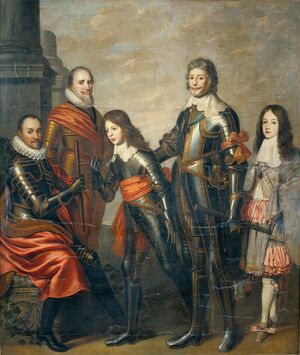
| وليام الأول 1772-1843، ملك هولندا، 1815-1840 | Wilhelmina of Prussia | ||||||||||||||||||||||||||||||||||||||||||||||||
| William II, 1792-1849, King of the Netherlands, 1840 | Anna Pavlovna of Russia | ||||||||||||||||||||||||||||||||||||||||||||||||
| Emma of Waldeck-Pyrmont | William III, 1817-1890, King of the Netherlands, 1849 | Sophia of Württemberg | |||||||||||||||||||||||||||||||||||||||||||||||
| Wilhelmina, 1880-1962, Queen of the Netherlands, 1890-1948 | Henry of Mecklenburg-Schwerin 1876-1934, Prince of the Netherlands | William, Prince of Orange 1840-1879 | Maurice, 1843-1850 | Alexander, Prince of Orange, 1851-1884 | |||||||||||||||||||||||||||||||||||||||||||||
| Juliana 1909-2004, Queen of the Netherlands, 1948-1980 | Prince Bernhard of Lippe-Biesterfeld, Prince of the Netherlands 1911-2004 | ||||||||||||||||||||||||||||||||||||||||||||||||
| Beatrix,1938-, Queen of the Netherlands,1980- | Claus van Amsberg,1926-2002, Prince of the Netherlands | Princess Irene of the Netherlands, 1939, m.(1964–1981) Carlos Hugo of Bourbon-Parma, Duke of Parma, 4 children not eligible for throne | Princess Margriet of the Netherlands, 1943- | Pieter van Vollenhoven | Princess Christina of the Netherlands,1947, m. Jorge Pérez y Guillermo (m. 1975; div. 1996), 3 children not eligible for throne | ||||||||||||||||||||||||||||||||||||||||||||
| Prince William-Alexander of the Netherlands,1967- Prince of Orange & Crown Prince, 1980 | Princess Máxima of the Netherlands & Princess of Orange | Prince Friso of Orange-Nassau 1968- m.(2004) Mabel Wisse Smit without permission, his children are not eligible for the throne and he is no longer a Prince of the Netherlands | Prince Constantijn of the Netherlands, 1969- | Princess Laurentien of the Netherlands | 4 sons, 2 of which eligible for throne | ||||||||||||||||||||||||||||||||||||||||||||
| Princess Catharina-Amalia of the Netherlands,2003- Hereditary Princess of Orange | Princess Alexia of the Netherlands, 2005- | Princess Ariane of the Netherlands, 2007- | Countess Eloise of Orange-Nassau, 2002- | Count Claus-Casimir of Orange-Nassau, 2004- | Countess Leonore of Orange-Nassau, 2006- | ||||||||||||||||||||||||||||||||||||||||||||
الدروع
Coat of arms of William the Silent as Prince of Orange from 1544 to 1582, and his eldest son Philip William[3]
The coat of arms used by William the Silent from 1582 until his death, Frederick Henry, William II, and William III as Prince of Orange[3]
An alternate coat of arms sometimes used by Frederick Henry, William II, and William III as Prince of Orange showing the county of Moers in the top center rather than Veere.[4]
Arms of the counts, later princes of Nassau-Dietz. They were usually elected stadholders of Friesland, and sometimes Groningen. They gave rise to the kings of the Netherlands. They show the county of Spiegelberg and the baronie of Liesveld on the bottom.[5]
Arms of the Princes of Nassau-Dietz (Henry Casimir II)at the end of the 17th century with the cross of the Teutonic Order in the center.[5]
Through the marriage in 1646 of Henry of Nassau-Siegen and Maria Magdalena of Limburg-Styrum the lordship of Wisch came into de protestant line of the house of Nassau-Siegen. The center shield shows Limburg-Styrum, with the county of Limburg in the 1st quarter, and then clockwise the lordships of Bronkhorst, Borculo, and Wisch.
Arms of the States-General of the Dutch Republic. The sword symbolizes the determination to defend the nation, and the bundle of 7 arrows the unity of the 7 United Provinces of the Dutch Republic.
Arms of William VI as sovereign prince of the Netherlands.[3]
First arms of the Kingdom and Kings of the Netherlands from 1815-1907.[7]
Arms of the Kingdom and Kings of the Netherlands since 1907.[7]
Personal coat of arms of William Alexander and his brothers.[7]
Personal arms of Juliana. The inescutcheon is her father's arms of Mecklenburg.[7]
Personal arms of Beatrix and her sisters. The inescutcheon is their father's arms of Lippe.[7]
Personal Arms of the children of princess Margriet of the Netherlands (Princes Maurice, Bernhard, Floris and Pieter-Christian). The inescutcheon is their father's arms of van Vollenhoven.[7]
الأعلام والدروع
دروع وأعلام الملك والملكة:
Standard of Marie of Wied, Princess of the Netherlands
الرموز
انظر أيضاً
المصادر
- ^ محمد حسن عبيد. "أورانج ـ ناسّاو". الموسوعة العربية. Retrieved 2012-06-19.
- ^ Delff, Willem Jacobsz. "De Nassauische Cavalcade". From an engraving on exhibit in the Rijksmuseum, Amsterdam. Rijksmuseum, Amsterdam. Retrieved 26 April 2011.
- ^ أ ب ت ث ج ح خ د ذ ر ز س Rietstap, Johannes Baptist (2003). Armorial general. Vol. vol.2. Genealogical Publishing Co. p. 297. ISBN 0-8063-4811-9.
{{cite book}}:|volume=has extra text (help) - ^ Post, Pieter (1651). "Coat of Arms as depicted in "Begraeffenisse van syne hoogheyt Frederick Hendrick"". engraving, in the collection of. Rijksmuseum, Amsterdam. Retrieved 1 June 2011.
- ^ أ ب ت ""Coat of Arms as depicted on the "Familiegraf van de Oranje-Nassau's in de Grote of Jacobijnerkerk te Leeuwarden"". Familiegraf van de Oranje-Nassau's in de Grote of Jacobijnerkerk te Leeuwarden. Retrieved 9 November 2011.
- ^ خطأ استشهاد: وسم
<ref>غير صحيح؛ لا نص تم توفيره للمراجع المسماةRietstap2 - ^ أ ب ت ث ج ح خطأ استشهاد: وسم
<ref>غير صحيح؛ لا نص تم توفيره للمراجع المسماةkoninklijkhuis
الأدب
- Herbert H. Rowen, The princes of Orange: the stadholders in the Dutch Republic. Cambridge and New York: Cambridge University Press, 1988.
- John Lothrop Motley, "The Rise of the Dutch Republic". New York: Harper & Brothers, 1855.
- John Lothrop Motley, "History of the United Netherlands from the Death of William the Silent to the Synod of Dort". London: John Murray, 1860.
- John Lothrop Motley, "The Life and Death of John of Barenvelt". New York & London: Harper and Brothers Publishing, 1900.
- Petrus Johannes Blok, "History of the people of the Netherlands". New York: G. P. Putnam's sons, 1898.
- Jonathan I. Israel, "The Dutch Republic: Its Rise, Greatness, and Fall, 1477–1806" Oxford University Press, 1995. ISBN 0-19-820734-4
- Pieter Geyl, "Orange and Stuart 1641-1672" Phoenix Press, 2002>
وصلات خارجية
- العائلة الملكية الهولندية – الموقع الرسمي
— بيت ملكي — عائلة اورانج-ناسو
| ||
| شاغر اللقب آخر من حمله عائلة هابسبورگ-لوريانبصفته العائلة الحاكمة في دوقية لوكسمبورگ |
العائلة المالكة في لوكسمبورگ 1815–1890 |
تبعه عائلة ناسو-ڤيلبورگ |
| شاغر اللقب آخر من حمله عائلة بوناپارتبصفته العائلة الحاكمة في مملكة هولندا |
العائلة الملكية هولندية 1815– |
تبعه شاغر |

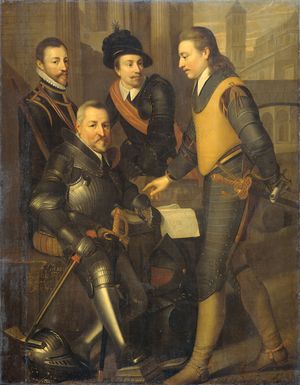
![Arms of the Ottonian Branch of the House of Nassau.[3]](/w/images/thumb/5/57/Wapen_Nassauw.svg/103px-Wapen_Nassauw.svg.png)
![Achievement of the Ottonian Branch House of Nassau (since the 13th century).[3]](/w/images/thumb/b/b2/Arms_Nassau.png/87px-Arms_Nassau.png)
![Arms of Engelbrecht II and Henry III of Nassau-Breda.[3]](/w/images/thumb/a/a6/Blason_Nassau-Vianden.svg/109px-Blason_Nassau-Vianden.svg.png)
![Arms of the counts of Nassau-Dietz, one of the cadet lines.[3]](/w/images/thumb/7/7c/Blason_Nassau-Dietz_%28selon_Gelre%29.svg/109px-Blason_Nassau-Dietz_%28selon_Gelre%29.svg.png)
![Coat of arms of Rene of Chalons as Prince of Orange.[3]](/w/images/thumb/8/8f/Blason_Ren%C3%A9_de_Nassau-Dillenbourg%2C_Prince_de_Ch%C3%A2lon-Orange.svg/109px-Blason_Ren%C3%A9_de_Nassau-Dillenbourg%2C_Prince_de_Ch%C3%A2lon-Orange.svg.png)
![Arms of William the Rich, count of Nassau-Dillenburg.[3]](/w/images/thumb/c/c3/Blason_Nassau-Dillenbourg.svg/109px-Blason_Nassau-Dillenbourg.svg.png)
![Coat of arms of William the Silent as Prince of Orange from 1544 to 1582, and his eldest son Philip William[3]](/w/images/thumb/0/0b/Blason_Nassau-Orange.svg/109px-Blason_Nassau-Orange.svg.png)
![The coat of arms used by William the Silent from 1582 until his death, Frederick Henry, William II, and William III as Prince of Orange[3]](/w/images/thumb/b/b0/Blason_Nassau-Orange_%28Cadets%29.svg/109px-Blason_Nassau-Orange_%28Cadets%29.svg.png)
![An alternate coat of arms sometimes used by Frederick Henry, William II, and William III as Prince of Orange showing the county of Moers in the top center rather than Veere.[4]](/w/images/thumb/9/98/Blason_Nassau-Orange_%28Cadets%29_Alternate.PNG/109px-Blason_Nassau-Orange_%28Cadets%29_Alternate.PNG)
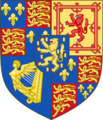
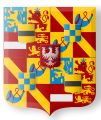
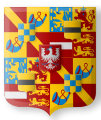
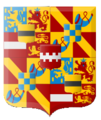
![Arms of Justinus van Nassau.[3]](/w/images/thumb/4/4d/Justinus_van_Nassau_wapen.svg/105px-Justinus_van_Nassau_wapen.svg.png)
![Arms of the branch Nassau-LaLecq.[3]](/w/images/thumb/f/f1/Blason_Nassau-LaLecq_Beverweert_Ouwerkerk_Odijk.PNG/109px-Blason_Nassau-LaLecq_Beverweert_Ouwerkerk_Odijk.PNG)
![Arms of the branch Nassau-Zuylestein.[3]](/w/images/thumb/0/00/Blason_Nassau-Zuylestein.svg/109px-Blason_Nassau-Zuylestein.svg.png)
![Arms of the counts, later princes of Nassau-Dietz. They were usually elected stadholders of Friesland, and sometimes Groningen. They gave rise to the kings of the Netherlands. They show the county of Spiegelberg and the baronie of Liesveld on the bottom.[5]](/w/images/thumb/c/c0/Nassau-Diez_1636_wapen.svg/101px-Nassau-Diez_1636_wapen.svg.png)
![Arms of the Princes of Nassau-Dietz (Henry Casimir II)at the end of the 17th century with the cross of the Teutonic Order in the center.[5]](/w/images/thumb/2/2a/Nassau-Diez_1640_wapen.svg/101px-Nassau-Diez_1640_wapen.svg.png)
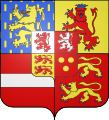

![Arms of Johan Willem Friso as Prince of Orange.[5]](/w/images/thumb/3/38/Arms_of_Johan_Willem_Friso_as_Prince_of_Orange.JPG/105px-Arms_of_Johan_Willem_Friso_as_Prince_of_Orange.JPG)
![Arms of William VI of Orange as prince of Orange-Nassau-Fulda. The bottom most shield shows clockwise from top left the principality of Fulda, the lordship of Corvey, the county of Weingarten, and the lordship of Dortmund.[6]](/w/images/thumb/2/2d/Wappen_Nassau-Fulda.svg/109px-Wappen_Nassau-Fulda.svg.png)
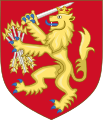
![Arms of William VI as sovereign prince of the Netherlands.[3]](/w/images/thumb/d/d5/Willem_VI_van_Oranje_Sovereine_Vorst_1814_-_1815.PNG/112px-Willem_VI_van_Oranje_Sovereine_Vorst_1814_-_1815.PNG)
![First arms of the Kingdom and Kings of the Netherlands from 1815-1907.[7]](/w/images/thumb/c/c9/Arms_of_the_Netherlands_%281815-1907%29.svg/100px-Arms_of_the_Netherlands_%281815-1907%29.svg.png)
![Arms of the Kingdom and Kings of the Netherlands since 1907.[7]](/w/images/thumb/6/61/Arms_of_the_netherlands.svg/100px-Arms_of_the_netherlands.svg.png)
![Personal coat of arms of William Alexander and his brothers.[7]](/w/images/thumb/b/be/Arms_of_the_children_of_queen_Beatrix_of_the_Netherlands.svg/100px-Arms_of_the_children_of_queen_Beatrix_of_the_Netherlands.svg.png)
![Personal arms of Juliana. The inescutcheon is her father's arms of Mecklenburg.[7]](/w/images/thumb/a/ab/Arms_of_Juliana_of_the_Netherlands_as_princess_%28before_1948%29.svg/100px-Arms_of_Juliana_of_the_Netherlands_as_princess_%28before_1948%29.svg.png)
![Personal arms of Beatrix and her sisters. The inescutcheon is their father's arms of Lippe.[7]](/w/images/thumb/5/5a/Arms_of_the_children_of_queen_Juliana_of_the_Netherlands.svg/100px-Arms_of_the_children_of_queen_Juliana_of_the_Netherlands.svg.png)
![Personal Arms of the children of princess Margriet of the Netherlands (Princes Maurice, Bernhard, Floris and Pieter-Christian). The inescutcheon is their father's arms of van Vollenhoven.[7]](/w/images/thumb/4/4b/Arms_of_the_children_of_princess_Margriet_of_the_Netherlands.svg/100px-Arms_of_the_children_of_princess_Margriet_of_the_Netherlands.svg.png)

